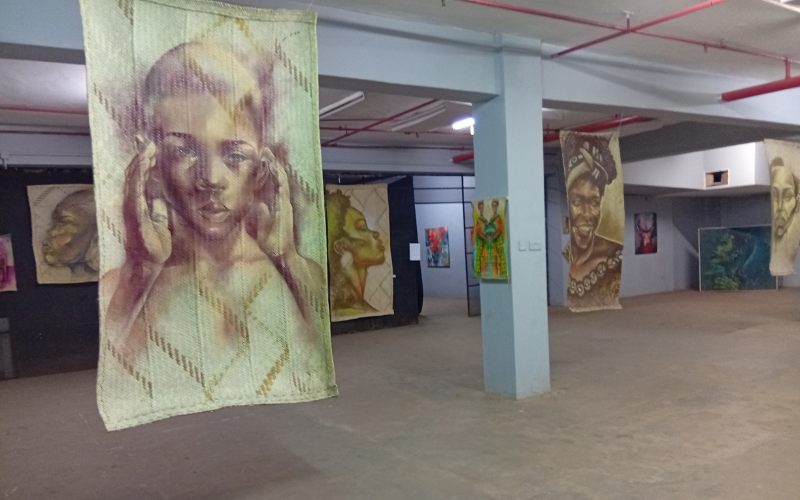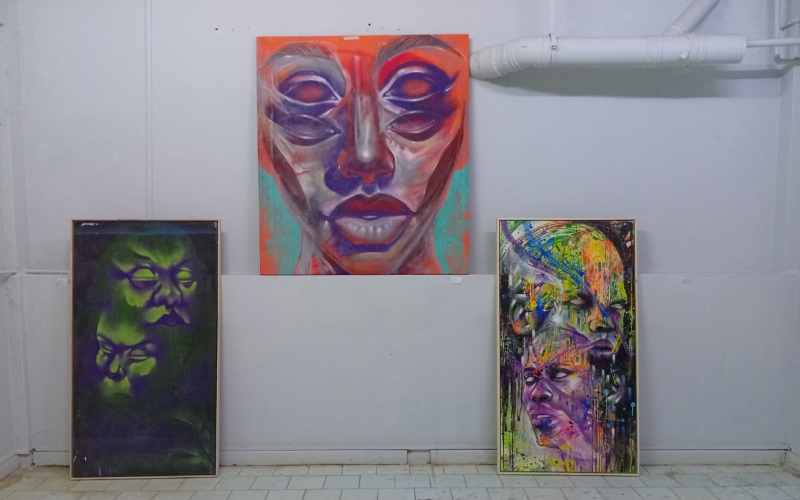Inside the Munyu Space, Nairobi, paintings are on makutis (palm leaves), mikeka (mats), and gunias (burlap sacks) that are suspended from the ceiling. The gallery features these artworks that show male and female portraits with stoic faces and ghostly and glaring eyes either looking at each other or at the viewer.
Several of them embody the graffiti’s colorful style, while others are in muted brown and golden tones.
And while most of them are untitled, there is one series titled ‘The People Shall’, with spray paint cans painted on them that pay homage to the 2024 anti-Finance Bill protestors.
These are some of the 70 pieces by Swift Graffiti for his ongoing groundbreaking exhibition titled ‘Interdimensionals: Body as Homes’. Swift created his works using spray paints. It is unusual for a graffiti artist to showcase at a gallery, but this is the direction that he and curator Joy Mala went with.
It was during the Covid-19 era that the veteran artist with a span of 20 years in the industry was seeking alternative ways for his art.
“I am an experimental artist; I like to explore different neighbourhoods with different surfaces and locations. During the pandemic, I realised that the spray paint goes well with makuti; it being handwoven makes its use unique,” he says.

He adds, “I listen to other peoples’ interpretation of my work and realise that my own interpretation has been interpreted in one hundred more ways by other people. It becomes more than my piece; it speaks to other people.”
Apart from using spray paint cans, sacks and palm fronds as his medium, he also explored digital prints on polyester and flag fabrics. Joy was in awe of the different approach he chose with his art.
“People love seeing art in unconventional materials. I was looking at the way he portrays bodies. He is good at portraiture paintings by making them prominent and powerful,” Joy says.
She describes the portrait figures as free to be and to exist with looks and bodies that are layered with resilience before colonialism.
“The figures are bold, and they stare deeply into one’s soul. It evokes the feeling of desiring to be here. I realised that people are shy to look at the male body, proving that there are a lot of internalized ideas that are not our own, but we confront them to challenge those perceptions,” she says.
Joy says these works come from different periods of his art practice since the year 2020, but the idea to exhibit them didn’t cross Swift’s mind until recently. He would create them in his studio without the intention of showing them at a gallery.

She views Swift’s first solo exhibition as an inspiration to the over 300 artists he has mentored. As one of the pioneer artists of graffiti matatu culture, she says this is a form of reassurance and inspiration to other graffiti artists.
Swift captures the themes of ancestral memory, resilience, commemoration of the dead, and hope. With ‘The People Shall’, Joy explains that the gory images were to represent the people who died during the protest and the collective resilience.
She said some of them projected messages of love while others advocated for constitutional freedoms. Showing these images on such materials using graffiti also projected freedom in its own way for the artist.
“The paintings show the happenings in the country right now, where we are protesting against the same tyrannical rule. We wanted to convey the message of solidarity and to be in touch with what happens on the ground. It is a message of inspiration even for the young people,” Joy says.
As a curator at Munyu Space, a Kenyan-themed exhibition gallery, Joy hopes to see more curators, galleries and galleries that are Kenyan-owned for more Kenyan artists to tell their stories, adding that most of their collectors are Kenyans.
Photos by Anjellah Owino


